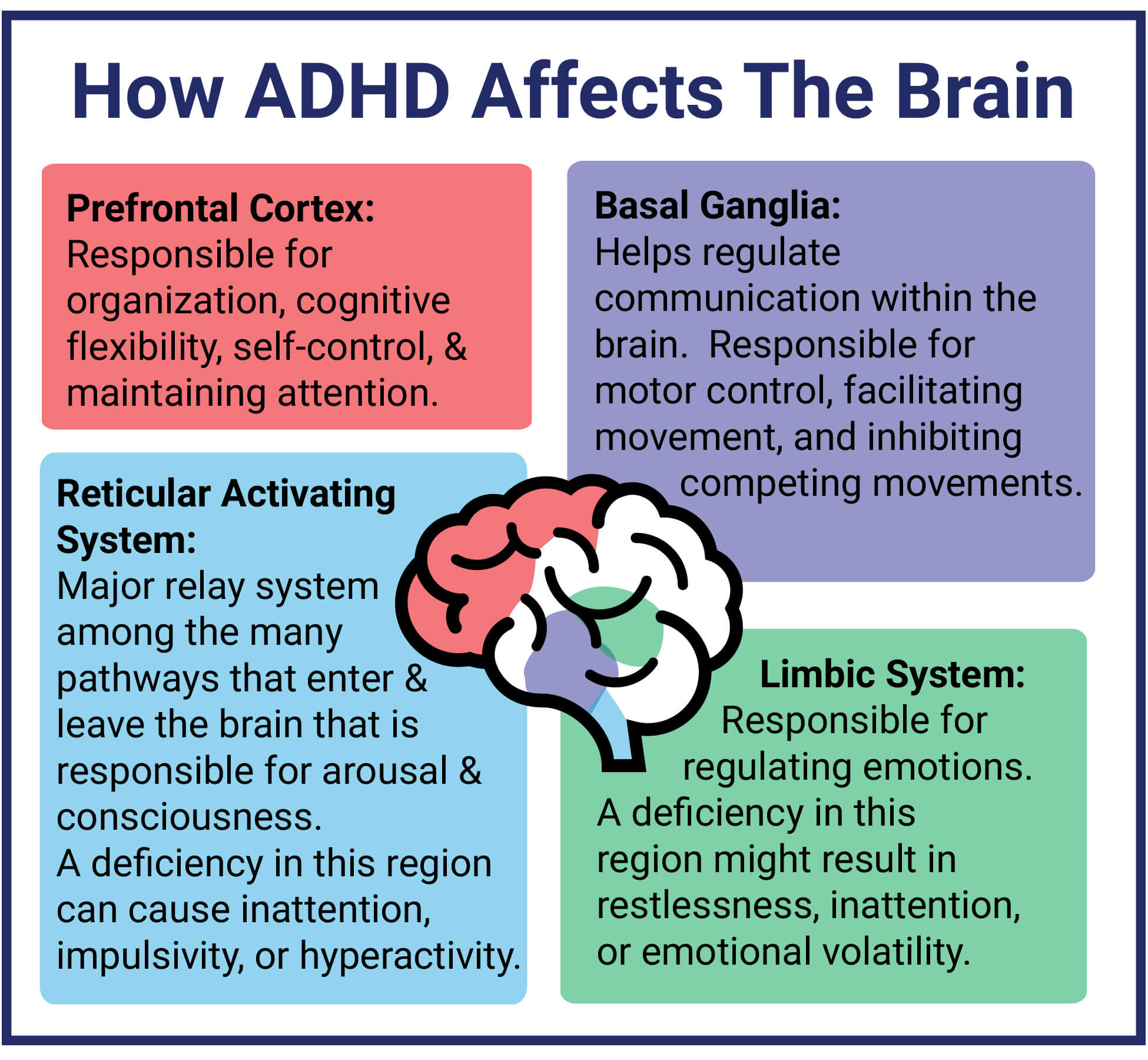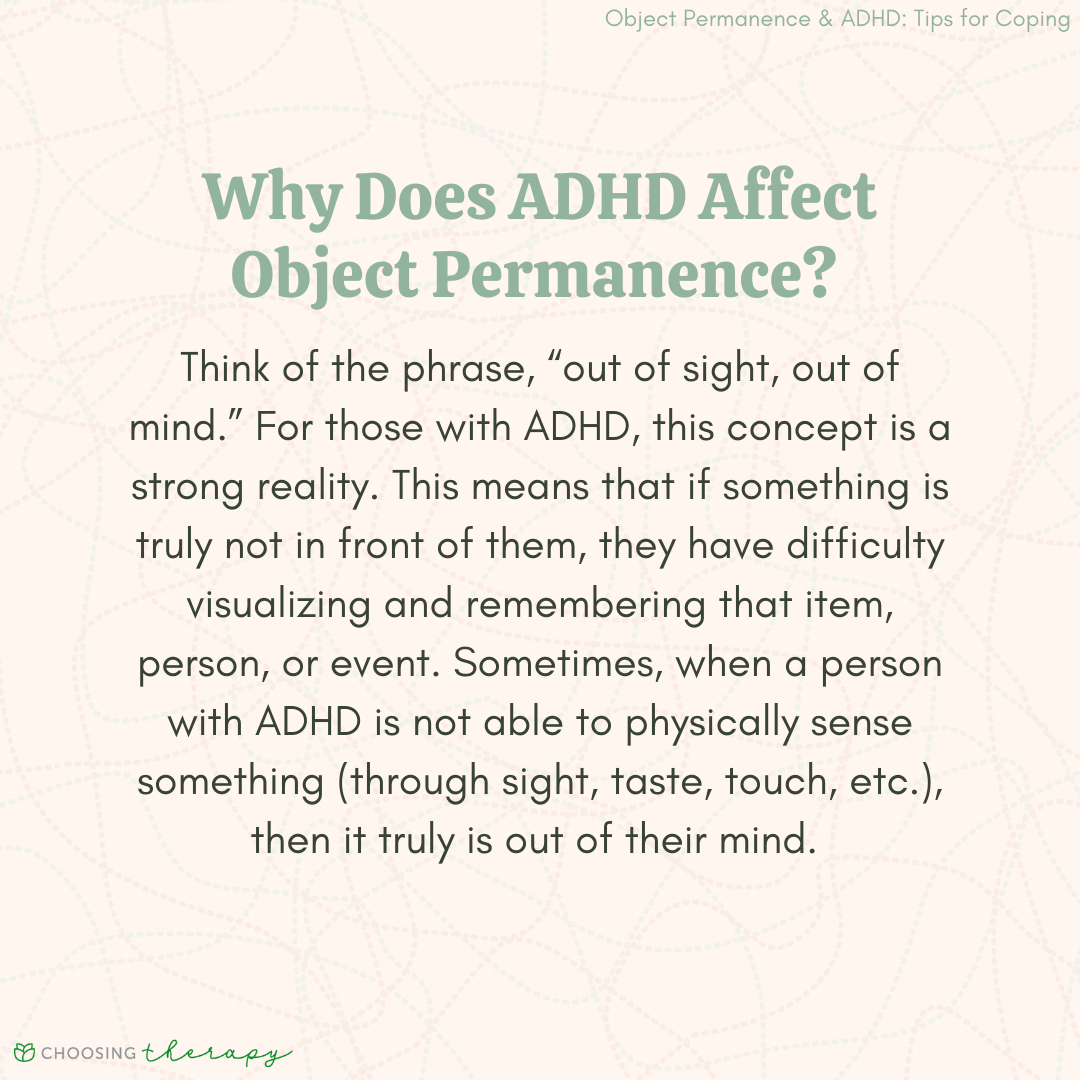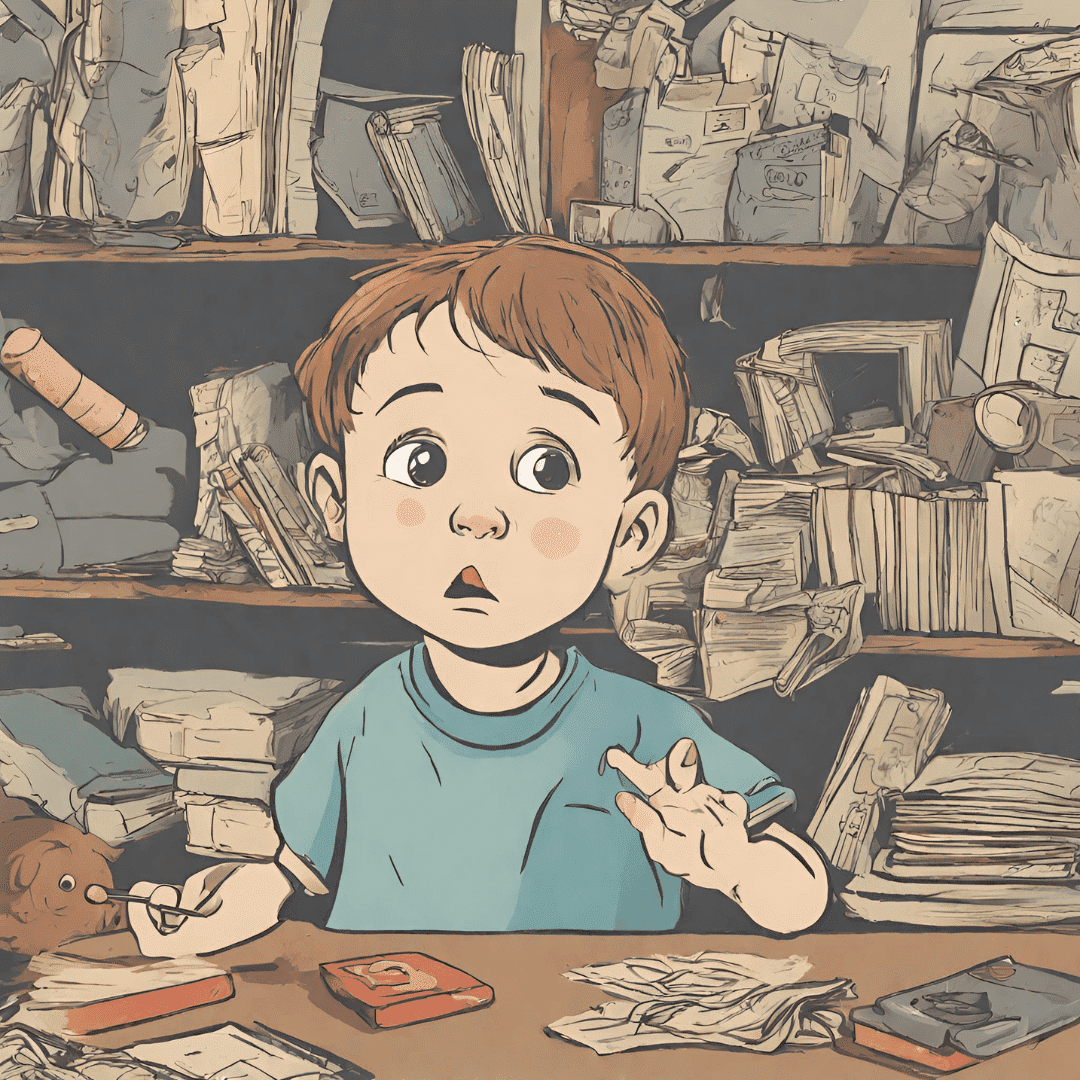Object Permanence ADHD: Do People With ADHD Struggle With Object Permanence
Defining cognitive milestones is crucial in understanding child development, particularly with the lens of certain behavioral and cognitive conditions such as Attention Deficit Hyperactivity Disorder (ADHD). Among these landmarks is the concept of object permanence – the understanding that objects continue to exist, even when they cannot be observed. This vital cognitive stage, which typically develops during infancy, is a precursor to abstract thought and memory development.
Object permanence is an integral part of an individual’s cognitive maturation process and influences how a person interacts with their world. Without a solid grasp of object permanence, a person’s ability to reason and understand cause and effect may be compromised, affecting their overall cognitive abilities. A prime resource for in-depth knowledge about this can be found on our page Object Permanence.
Explanation of ADHD and how it impacts cognitive function
In parallel, ADHD is a universally recognized neurodevelopmental disorder that commonly starts in childhood and can continue into adulthood. People with ADHD may experience symptoms such as impulsivity, hyperactivity, and issues with attention span. It goes without saying that these symptoms can dramatically impact a person’s daily life due to potential difficulties in managing time, organizing tasks, and maintaining relationships.
Definition and its Theoretical Framework
Origin of the concept in psychological studies
At the heart of cognitive development lies the concept of object permanence. Initially introduced by the illustrious child-development theorist, Jean Piaget, object permanence is characterized as the understanding that objects continue to exist even when they cannot be observed directly. This abstract concept is generally developed at the early stages of human growth.
How it’s typically developed in children
Typically, this crucial milestone is achieved by children around the age of 8-12 months. It starts with anticipatory tracking of objects in motion, often seen when a child visually tracks a toy being moved around. As a child’s cognitive skills develop, so too does their understanding of object permanence which eventually progresses to searching for hidden items and realizing that the absence of an object doesn’t equate to its non-existence.
It’s significance in cognitive development
The significance of object permanence in cognitive development is momentous. It lays the foundation for understanding abstract concepts, problem-solving skills, and enriches Cognitive Skills. The absence or delay in the development of this milestone often signifies potential issues in cognitive development.
Linking Object Permanence to ADHD
Research findings highlighting the connection
Over the years, extensive research has illuminated a compelling link between ADHD and the understanding of object permanence. While ADHD is characterized by difficulties in attention, impulse control, and hyperactivity, object permanence plays a significant role in cognitive development.
Possible reasons behind the difficulties
Children with ADHD may face challenges in mastering the concept of object permanence for various reasons. One key factor is the inherent impulsivity and distractibility associated with ADHD. These traits can hinder their ability to focus on and retain mental representations of objects when they are out of sight, which is a fundamental aspect of object permanence.
Case study insights
Numerous case studies provide valuable insights into the relationship between ADHD and object permanence. These studies showcase the effectiveness of CBT techniques in improving object permanence understanding among children with ADHD. The findings suggest that early intervention can significantly impact cognitive development in children with ADHD.
Possible Discrepancies in the Studies
Divergent research outcomes
While there is substantial research that supports the connection between ADHD and object permanence, it’s important to consider divergent research outcomes and critiques of the theory. Some studies conclude that children with ADHD do not show delayed object permanence. The discrepancy likely arises from variations in research methods and the Therapeutic Interventions applied.
Critiques of the theory
Additional factors for this discrepancy might involve the early ADHD signs taken into account during the studies, the child’s Education Strategies employed, and the diverse cognitive abilities among ADHD individuals. Thus, further exploration into this area is needed, including more comprehensive case studies and a broader, more in-depth approach to the theory of object permanence.
ADHD and its Cognitive Consequences

Definition and Key Signs of ADHD
It’s impact on the daily life
Attention Deficit Hyperactivity Disorder (ADHD) is a neurological condition that can significantly impact a person’s daily life. Symptoms manifest as persistent patterns of inattention, impulsivity, and sometimes hyperactivity that are inconsistent with the person’s developmental age.
How it affects learning and perception
This condition affects various aspects of an individual’s life, including learning and perception. For example, a student with ADHD might find it challenging to focus in a traditional classroom setting, often resulting in difficulty following instructions, completing assignments, or retaining learned information. These hurdles impact not only the academic journey of the individual but also their emotional and social sphere.
Real-life examples of individuals with ADHD
Real-life examples of individuals with ADHD highlight the struggles and opportunities that come with this condition. From a person who has learned to harness their hyperfocus to excel in fast-paced, demanding industries, to children who use creative outlets to manage their impulsivity – each story underscores the diverse impact of ADHD on everyday life.
Specific Cognitive Deficits in ADHD
Short-term and working memory performance
Individuals diagnosed with ADHD often present specific cognitive deficits relevant to the symptoms of their condition. Notably, this includes short-term and working memory performance, attention deficiencies, and hyperactivity, among others. The area of memory performance is especially significant when considering the skillset needed for successful learning and retention of information.
Attention deficiencies and hyperactivity
Moreover, ADHD can influence the regulation of attention and hyperactivity control in a person. This deficit can lead to excessive movement and difficulty in focusing, which might impact day-to-day activities, including classroom engagement, relationship management, and overall task execution.
Outlining scientific research on this area
Literature surrounding scientific research on cognitive deficits in ADHD is comprehensive, having discussions around genetic markers, neurotransmitter activity, and variations in brain architecture. This evidence confirms that ADHD is more than just a behavioral health disorder, but a complex neurological condition with physiological roots.
How These Deficits May Relate to Object Permanence

Comparing cognition-related symptoms in ADHD and Autism
Considering the prevalent cognition-related symptoms in ADHD, it seems plausible that these may influence the understanding of object permanence. In context, a link can be made when comparing the symptomatology in ADHD and Autism, two conditions known to influence cognitive development.
While it’s clear that ADHD affects attention and impulse control, the impact on the development of object permanence is less evident. ADHD can impede key learning techniques necessary for understanding object permanence due to focus shifting, or the lack of it, at critical development stages. However, this link between ADHD and object permanence isn’t as explicit or linear as it is with Autism. Instead, disruptions in the natural maturation process due to ADHD could create a backdrop in which object permanence is harder to grasp.
Reviewing research on ADHD and object permanence
To solidify this theory, it’s necessary to review existing research on ADHD and object permanence. Despite limited studies in this area, it’s plausible that ADHD, being a condition that alters cognitive processes, can potentially influence the understanding of object permanence in children. Further studies are critical for a definitive correlation.
Building the Bridge
Presenting Research Comparing ADHD and Autism
Common emotional and cognitive traits
While ADHD and autism are distinctive neurological conditions, several commonalities manifest in individuals suffering from them. Both conditions are characterized by emotional and cognitive traits that deviate from neurotypical development. These traits are usually seen in cognitive skills, behavioral patterns, and social interactions.
Showing the role of object permanence in each
Object permanence plays a definite role in both conditions. Within the realm of autistic child development, a delay or lack of understanding in object permanence correlates with the child’s cognitive and sensory abilities. In contrast, for ADHD, even though the connection is not as direct, ADHD-related deficits in attention and working memory could potentially affect the child’s understanding of object permanence.
Presenting studies that reveal possible correlations
There are numerous studies that establish a possible correlation between ADHD, autism, and object permanence. However, since object permanence’s role in ADHD isn’t as extensively researched as in autism, an in-depth comparative study is required to unravel more explicit links.
Illustrating Scenarios Where ADHD Might Influence Object Permanence

ADHD-related difficulties that may affect object permanence
Moving beyond theoretical research, real-life scenarios provide a practical perspective on how ADHD might influence object permanence. For instance, children with ADHD might experience difficulty remembering where an object is placed or might struggle with games like peek-a-boo that directly test object permanence.
Examples of how such issues might manifest
For a child with ADHD, issues such as lack of focus, poor memory, and dysregulated attention could manifest in daily life as difficulties in finding misplaced objects, an increased need for visual prompts, or struggles with tasks that require understanding of object permanence, like certain puzzles or games. Enhanced autism education strategies can help children with ADHD overcome these hurdles in a productive manner.
Using research to explain these scenarios
Understanding the link between ADHD and object permanence necessitates nuanced evaluation of presented research and individualized study of the child’s unique situation. Every child’s cognitive development journey differs, and their ADHD symptoms may vary widely, underscoring the need for personalized strategies in building object permanence competence.
Addressing Potential Objections and Disagreements
Revisiting critiques of the ADHD-object permanence link
The ADHD-object permanence link evokes multiple viewpoints. Critics argue that it pushes the limits of ADHD symptomatology since the condition is primarily characterized by attention and impulse control issues, not cognitive delays. Some maintain that while ADHD may lend challenges to learning object permanence, it doesn’t inherently impact the concept’s understanding.
Discussing why further research is required
Considering these critiques underpins the importance of further research. There’s need for comprehensive studies employing varied research methods, wider participant demographics, and long-term tracking of cognitive development markers in ADHD. This isn’t merely an academic pursuit but a pathway toward customizing therapeutic interventions, harnessing effective learning techniques, and fostering a more compassionate understanding of people with ADHD.
Wrapping Up
Reiteration and concise analysis of the key findings
In this cerebral journey, we have systematically explored the nature of object permanence and its relevance to cognitive development. We’ve shed light on how it’s related to neurological conditions like autism, delved into ADHD and its cognitive consequences, while painting a hypothesis about the real-life scenarios where ADHD might affect the understanding of object permanence.
Object permanence emerges as a crucial cognitive milestone, not just for neurotypical development but also on the spectrum of autism and ADHD. Disorders like ADHD, well-known for attention and impulsivity regulation challenges, create a backdrop where grasping concepts like object permanence could be a tangled task. While it isn’t as direct or extensively studied a relationship as autism and object permanence, the potential correlation is undeniable.
Attention must also be allocated to the divergent information that pervades the study of ADHD and object permanence. Conflicting research, largely due to varying methodologies and an array of ADHD symptoms, invites skepticism towards drawing a stark connection. Instead of discrediting the probable association, these controversies highlight the need for enhanced research in this subject-matter.
Encouragement for further research and the potential impacts on therapeutic approaches for ADHD
As we contemplate the landscape of ADHD’s impact on object permanence’s understanding, it’s essential to foster more comprehensive research. Explicitly, research that dives into diverse cognitive development pathways, deploys multiple methodological strategies, and evaluates broad demographic groups longitudinally. Further study not only begets nuanced understanding but can also refine therapeutic approaches and education strategies for children with ADHD.
There’s much to glean from the juncture of ADHD and object permanence. On one hand, the potential for reshaping therapeutic approaches and furthering the understanding of ADHD. On the other, the possibility for children with ADHD to embrace their unique cognitive journeys, empowered by awareness and adequately equipped with individualized learning techniques. The depths of this topic remain largely uncharted, teeming with queries ready to be asked and facets ready to be explored.


